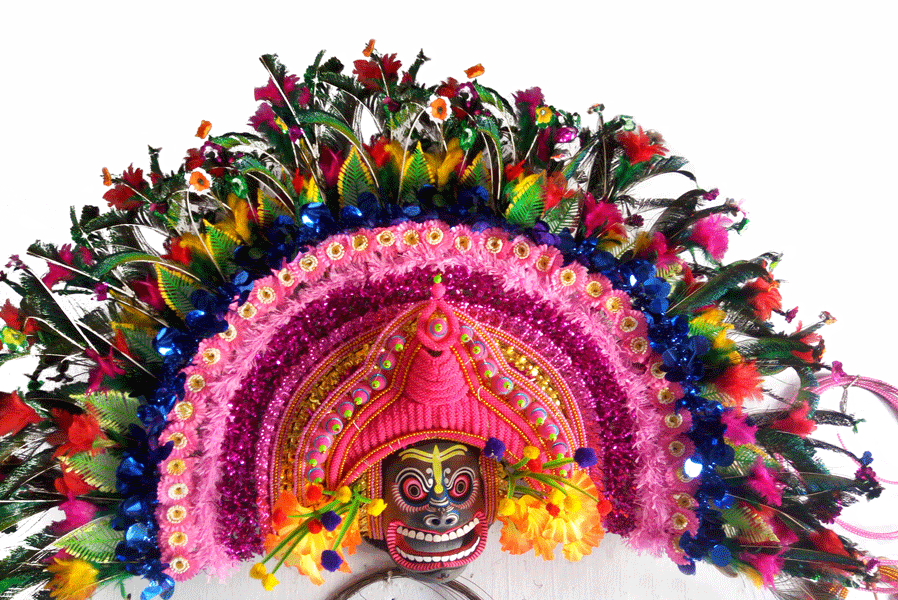Anil Sutradhar (92) recalls with pride that his art took him to places he had hardly dreamt of. The nonagenarian, who needs a stick to balance his wobbling legs, has hung outside his house a signboard with names of the countries he has visited and the years of his visits.

Sutradhar is a Chau mask maker and dance artist residing in Charida village in Purulia, around 300 km from Kolkata. He is perhaps the oldest artist who is well versed in making Chau masks. Chau is an acrobatic martial art-based dance form where the performers wear masks and dazzling costumes. Sutradhar quit dancing several years ago as he grew older, but continues to make Chau masks in his village.
Charida can be rightly termed as an ‘artisans’ village’ as around 250–300 families earn their livelihood by making the masks.
Charida village has the distinction of being the only place in the world where Chau masks are being manufactured. The tradition of making the masks began during the rule of King Madan Mohan Singh Deo of Baghmundi around 150 years ago.
“The artists used to perform in the King’s palace but slowly the art spread to nearby villages,” says Sutradhar. Till the early decades of this century, the dance form was patronised by the Baghmundi rulers, but due to unproductive land and less monsoons, they could hardly provide necessary support. The performers were forced to look for new areas to sustain their livelihood, he added.
Charida can be rightly termed as an ‘artisans’ village’, as around 250–300 families earn their livelihood by making these masks. Several shops selling the masks dot the village. Many of these craftsmen sell the masks from their homes. Interestingly, all the artisans have the common surname of Sutradhar.
The process
Raju, one of the artisans, is busy giving final touches to a Chau mask. With bulk orders, he hardly has time to spare, but agrees to explain the process that goes into making the masks. “A clay model of the mask is first made and dried in direct sunlight. It is then covered with powdered ash. Then successive layers of soft paper pulp mixed with gum from mulberry plant are pasted on the cast. After the rough foundation, the finer details are skillfully carved by applying a thin layer of clay. The entire cast is again dried in the sun, after which it is wrapped in a clay-soaked muslin cloth for a smooth finish. It is then polished with a wooden spatula. After a layer of zinc oxide, the mask is painted and decorated according to the character,” he says. The masks are generally inspired from mythological characters but some modifications have come up with the changing times, he adds.
He says that though they continue to make masks across the year, the season normally is six months, from March to May and November to January, when the dances are held in different villages.
The artisans rue that the mask-making can be a good market, nationally and internationally, but lack of infrastructure is a big hurdle. “Our village has good potential to attract tourists but lack of lodging facilities is a major roadblock. There are neither toilets nor decent food choices. The government has come with Biswa Bangla stalls to sell handicraft items but the rate of procurement is very low and all the artisans are not generally involved,” says Falguni Sutradhar, who has practised this art for over three decades.
There is huge demand for the masks in foreign markets but we lack proper export channels to meet it.
Raju Modak (25), an artisan, says that the business can be more profitable if the government shows more involvement. “Banks do not help us with loans as most of the artisans are defaulters. The art is unique and can be taken to other parts of the world. There is huge demand for the masks in foreign markets but lack of proper channels for exports prevents us from meeting it. The village has tremendous scope to contribute to State tourism being at the foot of the Ayodhya Hills, a tourist attraction.”
The State government “is helping them by organising fairs and other platforms to showcase their products. We are planning to come up with a cluster in Charida to bring different artisans under one roof. Their market has definitely increased in the past few years and more steps for their benefit would soon be taken,” said a government official.








